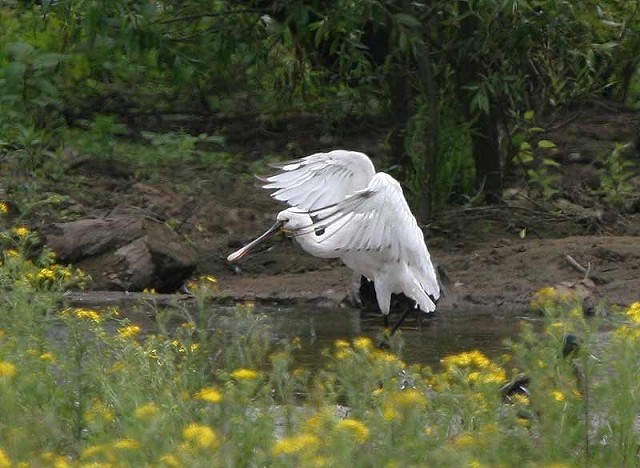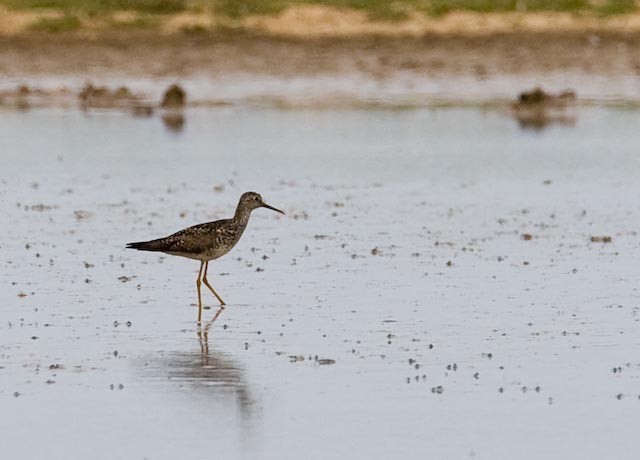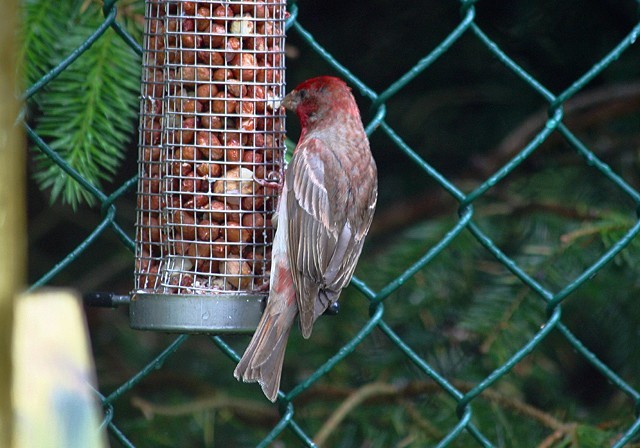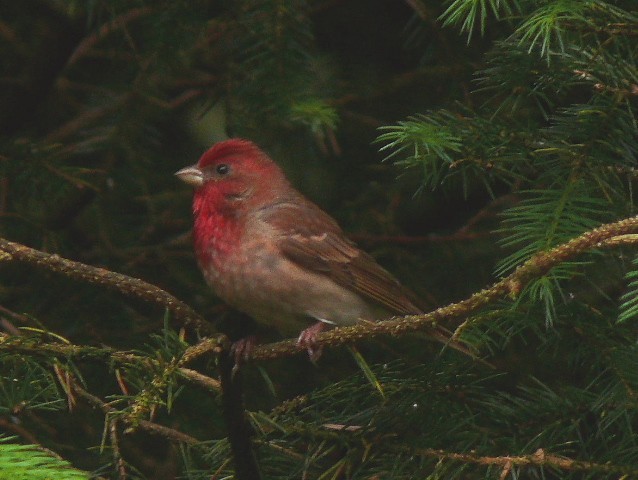The week at a glance
- Pacific Swift in East Yorkshire and a possible in Powys
- Probable Black-browed Albatross off Pembrokeshire
- Possible Hudsonian Whimbrel in East Yorkshire
- Lesser Grey Shrike in Norfolk
- Juvenile Black-winged Stilt predated in Cheshire
- Crossbill influx continues
As the spring migration season tailed off and Midsummer's Day came and went, it was probably to be expected that few new rarities turned up this week. A Pacific Swift was the pick of the crop, seen flying south over Beacon Ponds, Kilnsea (E. Yorks) on Sunday 22nd, but not seen again. There are just four accepted previous records of this Asian mega in Britain, the last (in 2005) also from the Spurn area. An unidentified swift with a white rump in the Elan Valley (Powys) on the same day as the East Yorkshire bird was also thought to be this species. The only other new megas of the week were both unconfirmed: a possible Hudsonian Whimbrel that roosted at Welwick (E. Yorks) on Sunday 22nd, and a probable Black-browed Albatross sighted in Ramsey Sound (Pembrokeshire) on Wednesday 25th. None of last week's megas persisted into this week, the River Warbler on Orkney not being seen after Wednesday 18th.

European Storm-petrel, Severn Beach, Gloucestershire (Photo: Paul Bowerman)
On the seawatching front, Cory's Shearwaters were sighted off Bridges of Ross (Co. Clare) and Kinnaird Head (Aberdeenshire), and Manx Shearwaters off Norfolk, Gloucestershire, Cornwall, Devon, Dorset, East Yorkshire, Cumbria, Lancashire and Gwent. Sooty Shearwaters appeared off Bridges of Ross (Co. Clare), Porthgwarra (Cornwall) and Flamborough Head (E. Yorks). Balearic Shearwaters were reported in numbers off southwestern coasts, with birds elsewhere reported from Norfolk, Kent, Jersey and County Clare. Pomarine Skuas were also restricted to southwestern coasts, with reports from Somerset, Devon and Cornwall, and no Long-tailed Skuas were reported. European Storm-Petrels were reported from western coastlines, among them those of Co. Cork, Cornwall, Cumbria, Dorset, Co. Down, Gloucestershire, Gwent, Skye, Lancashire, Pembrokeshire and Somerset.

Spoonbill, Sandbach Flashes, Cheshire (Photo: R.L.Brown)

Spoonbill, Sandbach Flashes, Cheshire (Photo: Steve Seal)

White Stork, Leominster, Herefordshire (Photo: George Ewart)
The only Cattle Egrets reported this week were at Slimbridge (Glos), where two birds remained to Sunday 22nd at least. Great White Egrets were reported from Jersey, South Yorkshire (a reappearance of a long-staying bird in the Hatfield Moors area) and Derbyshire (a delayed report of a flyover on 14th June). Spoonbill reports were widely scattered, from Devon, Dorset and Gwent in the southwest, Leighton Moss (Lancs) and Inner Marsh Farm (Cheshire) in the northwest, Filey (N. Yorks) in the northeast and Titchwell, Cley and Minsmere in the east. Inland birds remained into the last seven days at Elton Hall Flash (Cheshire), and at Old Moor and Rother Valley Country Park (S. Yorks), and a "new" bird was seen briefly at Broom Gravel Pit (Beds) in the early morning of Thursday 26th. The long-staying Glossy Ibis in Lancashire made a brief trip to Pilling Marsh on Sunday 22nd, and a possible seen by the M6 south of Carlisle the same day may have been the same bird, but it was back at Marshside RSPB by Tuesday 24th. A Common Crane flew into power lines at Lockerbie (Dumfries and Galloway) last week and was released at Caerlaverock on Thursday 19th, where it was still present on Saturday 21st. At least one Crane was still present at Sleap Moor (Shropshire) on Sunday 22nd. The elusive Black Stork that has led birders a merry dance in Buckinghamshire was seen over Dancersend on Monday 23rd; White Storks were at Greatham (Hants) on Sunday 22nd (possibly present for several days), at Watton Nature Reserve (E. Yorks) also on 22nd, and near Leominster (Herefordshire) on Tuesday and Wednesday (24th/25th) but not subsequently. The Night Heron was at Earith (Cambridgeshire) to Monday 23rd at least, and an adult was reported over Sizewell (Suffolk) on the evening of Sunday 22nd. Two Spotted Crakes were singing at both Sutton Gault (Cambridgeshire) and Minsmere (Suffolk) during the week, and the singing male Corncrake at Hurst (Berks) continued his lonely vigil until Tuesday 24th at least.
The 1st-summer drake Hooded Merganser remained at Radipole (Dorset) until Wednesday 25th at least, perhaps drawing more attention since the species' recent admittance into Category A of the British List. A drake Lesser Scaup popped up in Northern Ireland at Oxford Island (Co. Armagh) on Saturday 21st. The long-staying Surf Scoter was seen off Dawlish Warren (Devon) on Tuesday 24th (but not since) and the two drakes were seen again off Blackdog (Aberdeenshire), also on 24th, the first report of these birds for 10 days or so. The only Green-winged Teal reported was the drake at Inner Marsh Farm (Cheshire), to Wednesday 25th at least.
Honey Buzzards were seen regularly from the watchpoints at Great Ryburgh (Norfolk) and Wykeham Forest (N. Yorks) and other birds were reported from Binfield and Winnersh (Berks) and Hoo St. Werbergh (Kent) during the week. Black Kite reports came from Bilsdale (N. Yorks), Chatteris (Cambs), Stiffkey (Norfolk), Market Deeping (Lincs), Grimston (E. Yorks) and Knaresborough (N. Yorks) but none lingered. The only bird away from eastern counties was one over Overton (Hants) on the morning of Thursday 26th. An immature Red-footed Falcon was reported from Lakenheath Fen (Suffolk) on Thursday 19th (the female there having been last reported on 16th). New birds included a a male over Little Witcombe (Glos) on Saturday 21st and a possible female over Pett Levels (East Sussex) on Sunday 22nd.

Lesser Yellowlegs, Cley Marshes NWT, Norfolk (Photo: L. Steele)
Sadly, the surviving young Black-winged Stilt was predated on the evening of Friday 20th and the adults disappeared at some point on Saturday 21st. An adult American Golden Plover was seen on the Alaw Estuary (Anglesey) on Wednesday 25th. A Lesser Yellowlegs arrived on Simmond's Scrape at Cley (Norfolk) on Tuesday 24th and has been commuting between there and Pat's Pool since. A Red-necked Phalarope was seen to pass the Bridges of Ross (Co. Cork) on Sunday 22nd. The only Temminck's Stint of the week was one reported on Thursday 19th at Druridge Pools (Northumberland) but not seen the following day. A White-rumped Sandpiper graced Grove Ferry (Kent) on 19th and 20th.

Glaucous Gull, Pensarn, Conwy (Photo: Rob Sandham)
Rare gulls were unsurprisingly in short supply. An adult Laughing Gull flew northwards from Aghleam Bay (Co. Mayo) on Sunday 22nd; a Sabine's Gull was off West Runton (Norfolk) on Tuesday 24th; and the possible American Herring Gull remained on Chew Valley Lake (Somerset) to Wednesday 25th at least. The Forster's Tern also continued its long stay at Tacumshin (Co. Wexford), last reported on Tuesday 24th. Three Glaucous Gulls remained: a 2nd-summer at Mallaig (Highland), a 1st-year bird off Barvas (Lewis) and a first-summer bird at Pensarn (Conwy) - presumably the bird first reported here in April and later reported as an Iceland Gull earlier this month. Lingering Iceland Gulls were on St. Mary's (Scilly) and at Cartron Marsh (Co. Sligo), Eoropie (Lewis), Cruisetown Strand (Co. Louth), Nimmo's Pier (Co. Galway) and one flew past Portland Bill (Dorset) on Sunday 22nd.
The female Snowy Owl remained in the vicinity of Balranald (N. Uist) to Tuesday 24th, but the frustratingly nearby male (only 8 or 9 miles away at Greinetobht) has not been reported since 17th and was not present on 24th. A possible Alpine Swift was over Stowe Park (Bucks) on Monday 23rd. Four Bee-eaters were reported this week: a bird at Brandon Marsh (Warks) on the morning of Sunday 22nd but not subsequently, a bird over Belton Common (Norfolk) the same day, one on Ramsey Island (Pembrokeshire) on Tuesday 24th and the last over Coventry (West Midlands) the following day. Hoopoes were briefly in West Yorkshire and Aberdeenshire on 19th and 22nd respectively, and a third bird was reported in Isleworth (Greater London) over the weekend.

Lesser Grey Shrike, Hickling village, Norfolk (Photo: Jamie Wells)

Lesser Grey Shrike, Hickling village, Norfolk (Photo: Dave Sivyer)

Melodious Warbler, Jackhouse Reservoir, Lancashire (Photo: Gavin Thomas)
A female Lesser Grey Shrike was at Hickling (Norfolk) from Thursday 19th until Tuesday 24th, but has not so far been seen subsequently. Red-backed Shrike reports came in from Dorset, Norfolk, Fair Isle and West Sussex; the Norfolk bird was a male present at Sea Palling from Thursday 19th to Wednesday 25th. The male at Burton Mill Pond (West Sussex) was last reported on Sunday 22nd after a stay of over three weeks. The only Bluethroat of the week was a female reported at Landguard Common on Wednesday 25th. Marsh Warblers were reported from Skaw (Unst, Shetland) and Priorslee Lake (Shropshire) but a singing bird initially reported as this species at Jackhouse Reservoir between Blackburn and Haslingden (Lancashire) was later reidentified as an Icterine Warbler and then finally as a Melodious Warbler, trapped and ringed on Saturday 21st. The last report of this bird was on Monday 23rd. A Sardinian Warbler was at Flamborough Head (E. Yorks) on the morning on Monday 23rd.

Common Rosefinch, Tyndrum, Forth (Photo: Willie Mcbay)

Common Rosefinch, Tyndrum, Forth (Photo: Kris Gibb)
The Common Rosefinch continued to boost takings by visiting feeders at a café in Tyndrum (Forth) to Wednesday 25th at least. Also on garden feeders was an adult Rose-coloured Starling in Newburgh (Aberdeenshire) and other birds were at Rhosneigr (Anglesey), Lytham St. Anne's (Lancs), and on South Ronaldsay and on mainland Orkney at Stromness. The influx of Common Crossbills continued, with reports from Scilly to South Uist, though with a hint of an easterly bias.
Photo of the Week

Peregrine Falcon, undisclosed site, Shropshire (Photo: Jim Almond)
As the fastest creature on Earth, many regard Peregrine Falcons as the ultimate bird of prey. Their colonisation of cities has made them more accessible to people in general, whilst the mixed fortunes of their breeding attempts make for popular news stories. At this time of year, juvenile Peregrines that managed to fledge successfully can be seen developing their mastery of flight and hunting, with aerial manoeuvres like the 'food pass' forming an essential part of their training. Freezing a pair of juvenile birds as they met in mid-air, Jim Almond has frozen a wonderfully aerobatic interaction between these magnificent birds.
Note: The cut-off for this week's Photo of the Week selection was on Tuesday, a day earlier than usual. Images uploaded after the cut-off will go into next week's selection process.
Other notable photos

Woodchat Shrike, Spain (Photo: Steve Fletcher)

Common Kingfisher, Lackford, Suffolk (Photo: Garth Peacock)

Great Skua, Applecross, Highland (Photo: Dean Eades)

Common Tern, Whisby Pits NR, Lincolnshire (Photo: Matt Latham)

Hobby, Summer Leys LNR, Northamptonshire (Photo: Richard Bedford)

Puffin, Herm, Guernsey (Photo: Paul Hillion)

Pied Flycatcher, Undisclosed site, Gwynedd (Photo: Richard Steel)

Goldcrest, Llangollen, Clwyd (Photo: Steve Round)

Puffin, Farne Islands, Northumberland (Photo: Richard Steel)

Corncrake, Balranald RSPB, N.Uist, Outer Hebrides (Photo: Mark Taylor)

Dipper, Blackpool Mill, Pembrokeshire (Photo: Richard Crossen)

Little Owl, Netherlands (Photo: Cor Moesbergen)

Osprey, undisclosed site, Highland (Photo: Marcus Conway)

Golden Eagle, Islay, Argyll (Photo: Kev Joynes)

Chough, Islay, Argyll (Photo: Kev Joynes)

Manx Shearwater, Ardrossan, Ayrshire (Photo: Simon Boothroyd)

Common Sandpiper, Findhorn Valley, Highland (Photo: Marcus Conway)

